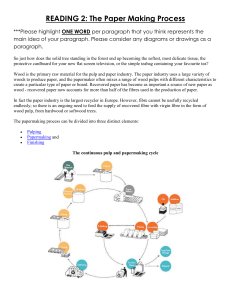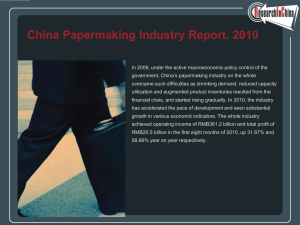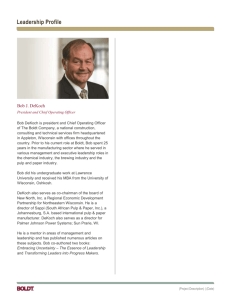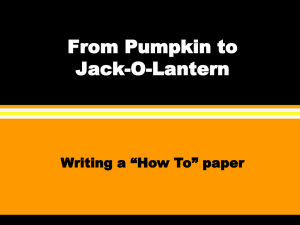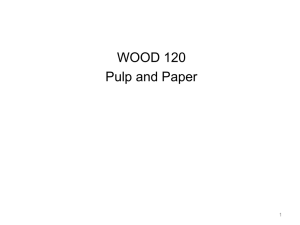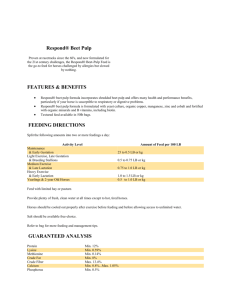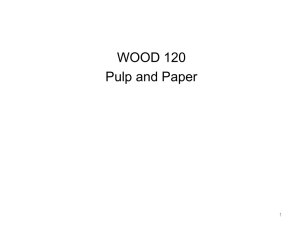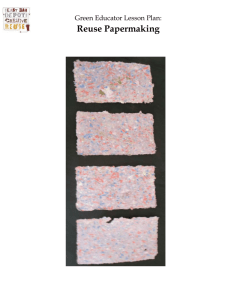Word / Term - Penicuik Papermaking
advertisement
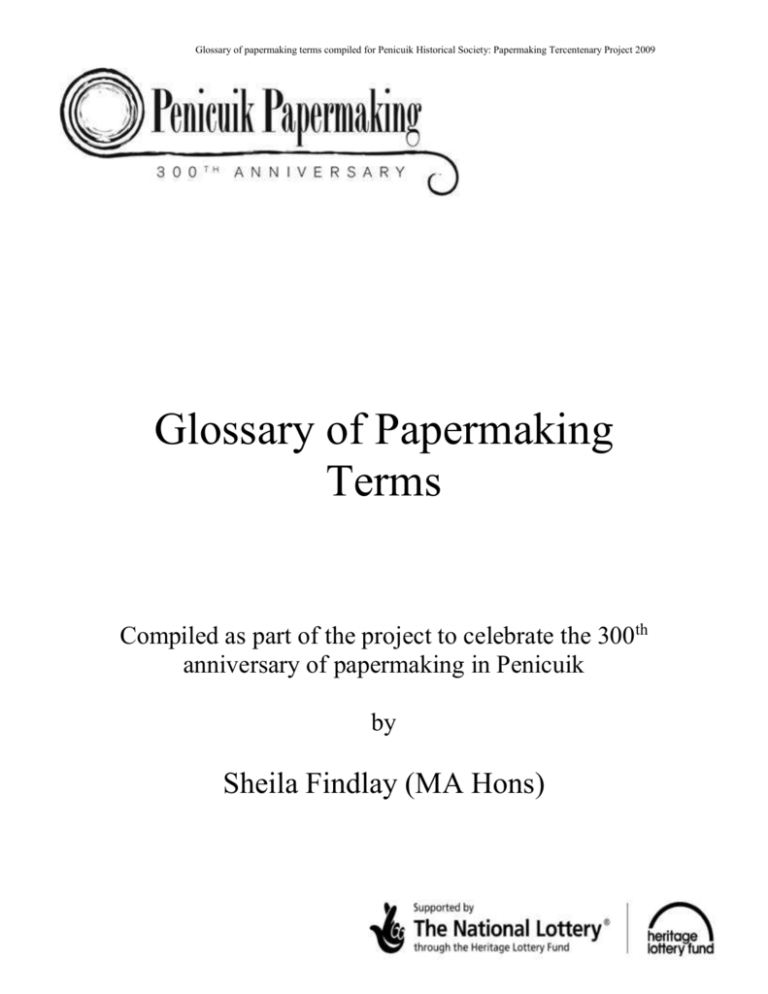
Glossary of papermaking terms compiled for Penicuik Historical Society: Papermaking Tercentenary Project 2009 Glossary of Papermaking Terms Compiled as part of the project to celebrate the 300th anniversary of papermaking in Penicuik by Sheila Findlay (MA Hons) 1 Glossary of papermaking terms compiled for Penicuik Historical Society: Papermaking Tercentenary Project 2009 Word / Term A Acid free Alum B Backwater Beater Beating Bleach Breaker Broke, Brock C Calender Calendering Calender nips Caliper Casein adhesive Cellulose Chemical wood pulp China clay Coated papers Definition Paper free from any acid content. Aluminium sulphate, added to gelatine in the sizing of paper to stabilize the gelatine. Also used to bond rosin size to fibres to make paper water resistant. Water containing small amounts of fibre and filler, which drains through the PM wire, and is recycled into the paper stock preparation system via the Saveall Introduced mid-seventeenth century and superseded the method of preparing pulp by hammering or stamping the rags. Process of reducing raw materials to a fibrous state in the production of pulp. Chemical used to whiten paper pulp, often a chlorine solution. Reduces rags to smaller pieces for beating. Flawed paper, which is discarded at any stage during its manufacture and is usually re-pulped. There are two kinds wet broke, which is accumulated at the wet end of the papermaking machine; dry broke which is accumulated at any stage on the dry end of the machine: trimmings from the reeling, slitting and cutting operations, as well as paper or board rejected during sorting. Stack of chilled-iron rollers at the end of the paper machine to smooth paper. Process of pressing paper through a calendar to smooth or glaze a sheet of paper during the finishing process. Normally used to describe the contact zone between two rolls. The thickness of a sheet of paper measured under standard test conditions. Product made by dissolving casein, a protein obtained from milk, in an aqueous alkaline solvent. Casein glues are generally superior to true animal glues in moisture resistance and aging characteristics. Casein also is used to improve the adhering characteristics of paints and coatings. Basic chemical compound of paper manufacture derived from plant tissues. Wood reduced to pulp by a chemical process, e.g., with caustic soda or bi-sulphite of lime. Fine clay or kaolin used as a pigment filler in the paper to aid smoothness, increase opacity, and reduce cost. Also used in coating to increase surface smoothness. Paper to which a coating has been applied on one or both sides, using a mix of clay or carbonates and bound by Casein, 2 Glossary of papermaking terms compiled for Penicuik Historical Society: Papermaking Tercentenary Project 2009 Coating Coucher Couching Couch rolls Curl Cylinder D Dandy roll Deckle Deckle edge Deckle slip Digester Dry end E Effluent latex or starch to create a high quality printing surface. The Liquid mixture applied to the surface of paper to make it more suitable for some methods of printing. Person who transfers newly formed sheets of paper from hand moulds to felt blankets. Action of transferring sheets of newly formed paper from hand moulds to felt blankets. Rolls at the end of a Fourdrinier machine to transfer the paper from the moving wire to a felt blanket. Deformation of a sheet of paper or board over its entire surface, which therefore tends to roll up into the form of a cylinder. Term indiscriminately applied to various kinds of rolls or drums on paper machines. More particularly the steam heated cylinders for drying paper. Light skeleton roll or cylinder covered with wire which presses gently on the paper while still wet. It helps to improve the formation of the sheet by gently pressing the top surface and can be used to impart a laid or wove look-through. Also used to impress a watermark into the top surface of paper by images attached to the roll. On a hand mould this is the removable frame which retains the pulp on the cover while the water drains through. On a Fourdrinier machine, the deckle strap performs the same function on the moving wire. Also used as term for the width of paper being made on the paper machine. Slightly wavy line to the edge of handmade paper, formed by a slight thinning of the edge of the sheet by pulp creeping under the edge of the deckle during forming of the sheet. Strip of wood fixed to the underside of the deckle to stop the pulp from creeping. Vessel in which wood chips, rags or esparto grass are boiled with chemicals. It can be stationary or revolving, horizontal or upright, cylindrical or spherical. Sometimes referred to as a boiler. Term for the drying section of the paper machine consisting of the drying cylinders, calender, reel. etc. Liquid waste discharged from mill at end of papermaking process. 3 Glossary of papermaking terms compiled for Penicuik Historical Society: Papermaking Tercentenary Project 2009 Effluent Clarifier Esparto grass F Felts Felt mark Felt side Fibres Filler Finish Finishing Finishing House Fourdrinier G Gelatine Glaze Guillotine Large circular tank that receives the entire outflow from a mill, where all the solids are settled to the bottom using chemical flocculants, and the clarified water flows from the top, into the river. The solids are pumped out from the bottom and are disposed of in land-fill. In modern plants, the water is passed through an aeration pond to restore oxygen, before return to the river. A coarse grass from Southern Spain and Northern Africa, employed principally by English and Scottish papermakers. Papers made from Esparto have a good writing and printing surface, are opaque and of good bulking properties. They are largely used for lithographic printing, for book production and as body papers for coating. Material woven from either cotton or wool with a raised surface which supports the wet sheet of paper during the stages of removal of water. Texture acquired on the surface of the paper from the felt. The side of the paper in contact with the felt after forming, opposite to the wire side. Fibres for papermaking are derived from plants, mainly wood, cotton, linen, esparto and straw, the important constituent being cellulose, the important constituent being cellulose. Usually mineral pigments (e.g clay or calcium carbonate) added to the paper to improve smoothness and opacity. Term used to describe the nature of the surface of a sheet of paper. Process of imparting the final surface to a sheet of paper. The department of the paper mill where paper is sorted and counted Name applied to the paper machine after the Fourdrinier brothers who financed its early development. It produces a continuous web of paper and was developed by Bryan Donkin from the original invention of Nicholas-Louis Robert. It is distinguished from other machines by the use of the long endless wire or fabric where the web is initially formed. Nitrogenous constituent of skin, bones, and hooves of animals, used as a size added to the dry sheet, has the added effect of strengthening the surface of the sheet. Gloss or polish on a sheet of paper. Machine used to cut reams of paper to exact size. 4 Glossary of papermaking terms compiled for Penicuik Historical Society: Papermaking Tercentenary Project 2009 H Hand made Headbox Hollander L Leverman M Mechanical wood pulp N Nip, nip accident O Overhaul Overhauler P Paper Break Pidge, The PM Potcher Pulp Q Quire R Rags The original method by which paper was made. The sheet is formed by dipping a mould into the pulp vat and taking up sufficient ‘stuff’ to form a sheet of paper of the required substances. A peculiar movement is required to felt the fibres together, and this is the only acquired after long practice and experience. A tank supplying papermaking stock under a controlled pressure. Another name for Beater, introduced mid seventeenth century and superseded the method of preparing pulp by hammering or stamping the rags. Person who takes stacks of felted sheets to a levered screw to extract surplus water. Pulp prepared by purely mechanical means, e.g., by grinding logs of wood. Injury to hand sustained when feeding paper on to calendars. Check each sheet of paper for defects. Person, usually a woman, who checked for defects, rejecting some for broke and putting aside others for cutting. When the sheet on the paper machine breaks due to various reasons, and has to be re-established on the reel (see”Tail”) Clocking-in house or area within a department used by supervisors for tasks and breaks. Also used for small office within a department. Paper machine. One of a series of beaters or engines used in washing and preparing pulp, especially applies to esparto. The aqueous stuff containing disintegrated cellulose fibre from which paper is made. Originally a quantity of twenty-four sheets of paper, now measured at twenty-five sheets. Formerly the principal raw material for making paper, now rarely used except for very high quality papers. Could be linen or cotton but by association also includes jute, sailcloth and hemp ropes. 5 Glossary of papermaking terms compiled for Penicuik Historical Society: Papermaking Tercentenary Project 2009 Ream Reel S Salle Saveall Sheet Size Sizing Soda process Stamper Stamps Stuff Sulphate process Supercalender T Tail Tub sized Term used for a quantity of sheets of paper, traditionally twenty quires (480 sheets) of paper but could vary with the type of paper. Now consists of 500 sheets General term for the revolving frame or drum which receives the paper coming off the machine. Room in the paper mill where sorting, curing and packing of paper took place. Also the department of the paper mill, sometimes called the Finishing House, where paper is sorted and counted. Device used to filter out fibres and filler from PM backwater, for recycling to the system, and clarify the water for reuse in PM wire sprays. Piece of paper or board, generally rectangular. Originally a solution of glue or gelatine but later any substance that reduces the rate at which paper absorbs water or ink. Can be applied by coating the finished sheet or by addition to the pulp before forming. See also tub-sized and engine-sized. Process of treating the paper with size. Alkaline treatment of wood for the production of chemical wood pulp by digesting the fibres under pressure with a solution of caustic soda. Early machine for making pulp, consisting of several sets of large wooden hammers falling into mortars filled with rags. Superseded by the beater. Defective marks on paper particularly from foreign matter on calender rolls. Paper stock or pulp ready for making into paper. Method of cooking wood chips generally in sulphate of soda to produce chemical wood pulp, introduced by Dahl in 1884. Set or stack of rollers separate to the paper machine to smooth paper, may have heated rolls. Is usually made up of alternating chilled-iron rolls and soft rolls made from compressed textile or paper, to give a very high smoothness. A narrow strip of paper cut on the PM wire and threaded through the machine and on to the reel, before being gradually widened to full width again. This is used to re-establish the sheet after a paper break Refers to sizing applied to paper by soaking it in a solution of hot gelatine and alum after it has been formed, pressed, dried and allowed to cure. 6 Glossary of papermaking terms compiled for Penicuik Historical Society: Papermaking Tercentenary Project 2009 V Vat Vitriol W Watermark Wet end Originally the tank containing the stuff from which hand made paper was produced but later also applied to the tank in which the cylinder of a mould machine is partially immersed. Sulphuric acid. A deliberate design or pattern in the paper. On a mould machine the design is sewn on to the wire covered cylinder so the paper is formed around the mark giving a good clear watermark. On a Fourdrinier machine the watermark is created by a dandy roll as the stock passes through the wet end processes. A watermark can be seen by holding the paper up to the light. The first stages of a papermaking machine before the drying process; at the wet end, stock is fed in and much of the high percentage of water is eliminated by drainage, suction and press rollers, leaving a web of paper which then passes to the drying cylinders. Sources: Primary Sources: Oral Histories recorded for Penicuik Historical Society’s Papermaking Tercentenary Project, 2009. Members of Steering Group for above. Secondary Sources: http://www.baph.org.uk http://www.paper.org.uk/information/pages/glossary.html http://www.inveresk.co.uk/content/glossary-terms http://www.britannica.com/EBchecked/topic/5823/adhesive/82530/Casein-glue 7
